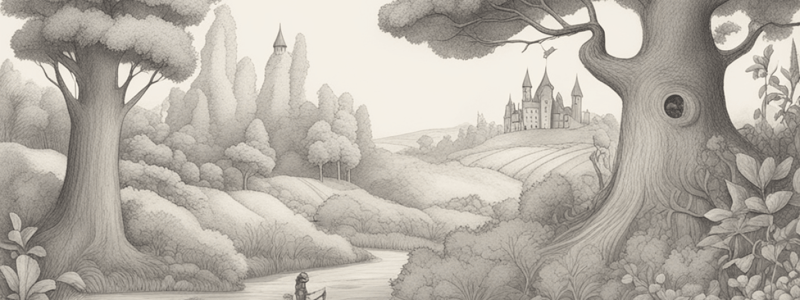Podcast
Questions and Answers
What is the primary function of the respiratory system?
What is the primary function of the respiratory system?
- To exchange gases (correct)
- To digest food
- To produce energy for the body
- To transport nutrients
Which of the following is NOT part of the respiratory system?
Which of the following is NOT part of the respiratory system?
- Pharynx
- Trachea
- Bronchi
- Stomach (correct)
Where does gas exchange primarily take place in the lungs?
Where does gas exchange primarily take place in the lungs?
- Pharynx
- Bronchioles
- Alveoli (correct)
- Mouth
What is the process called where the respiratory system draws air into the lungs and expels it out?
What is the process called where the respiratory system draws air into the lungs and expels it out?
What is the primary function of the respiratory system?
What is the primary function of the respiratory system?
Where does the process of gas exchange occur in the lungs?
Where does the process of gas exchange occur in the lungs?
What is the role of hemoglobin in the respiratory system?
What is the role of hemoglobin in the respiratory system?
What happens as air enters the lungs during inhalation?
What happens as air enters the lungs during inhalation?
What is the function of the bronchial tree in the respiratory system?
What is the function of the bronchial tree in the respiratory system?
How does carbon dioxide leave the body during exhalation?
How does carbon dioxide leave the body during exhalation?
Flashcards
Respiratory System
Respiratory System
The network of organs responsible for gas exchange (oxygen intake and carbon dioxide removal).
Lung Anatomy
Lung Anatomy
The structure of the lungs, including the lobes and alveoli.
Alveoli
Alveoli
Tiny air sacs in the lungs where gas exchange occurs.
Pulmonary Ventilation
Pulmonary Ventilation
Signup and view all the flashcards
Inspiration
Inspiration
Signup and view all the flashcards
Gas Exchange
Gas Exchange
Signup and view all the flashcards
Hemoglobin
Hemoglobin
Signup and view all the flashcards
Oxygen (O2)
Oxygen (O2)
Signup and view all the flashcards
Carbon Dioxide (CO2)
Carbon Dioxide (CO2)
Signup and view all the flashcards
Diaphragm
Diaphragm
Signup and view all the flashcards
Study Notes
Breathing and Exchange of Gases: Exploring the Respiratory System, Lung Anatomy, and Gas Exchange
The human respiratory system is an intricate network of organs and processes that enables our bodies to perform a vital duty: the exchange of gases. Specifically, we breathe in oxygen (O2) from our environment and release carbon dioxide (CO2) as a waste product. In this article, we will dive into the structure and functions of the respiratory system, the anatomy of the lungs, and the process of gas exchange.
The Respiratory System
The respiratory system is responsible for the gas exchange that occurs in our bodies. It comprises the nose, mouth, pharynx, larynx, trachea, bronchi, bronchioles, and the lungs. The primary organs involved in gas exchange are the lungs, which are subdivided into several smaller segments, called lobes.
Lung Anatomy
The lungs are two, sponge-like organs that fill most of the chest cavity. They are protected by the ribcage and enclosed by the diaphragm, a muscular dome-shaped sheet that separates the chest cavity from the abdominal cavity. The lungs contain millions of tiny air sacs called alveoli, which are surrounded by a network of capillaries. These alveoli and capillaries form the basis for gas exchange in the lungs.
Pulmonary Ventilation
Pulmonary ventilation is the process where the respiratory system draws air into the lungs and expels it out. This occurs through a series of mechanical movements:
- Inspiration: Inhale air containing oxygen through the nose or mouth, which then travels down the pharynx and larynx, and enters the trachea.
- Bronchial tree branching: The trachea divides into right and left bronchi, which further branch into smaller bronchioles.
- Alveolar ducts: The bronchioles terminate in the alveoli.
As air enters the lungs, the diaphragm and intercostal muscles relax, creating a negative pressure in the chest cavity. This pressure difference, combined with the elastic recoil of the lungs, causes air to flow into the lungs.
Gas Exchange
The gas exchange that occurs in the lungs is a critical function that enables our bodies to extract oxygen from the air and release carbon dioxide. This process is facilitated by the thin walls of the alveoli and capillaries.
- Oxygen (O2) inhaled from the air dissolves into the fluid lining the alveoli.
- Oxygen then diffuses across the thin alveolar walls and into the capillaries.
- Oxygen binds to hemoglobin molecules in red blood cells, which then transport it to the body's tissues.
Gas exchange occurs simultaneously for carbon dioxide (CO2).
- Carbon dioxide is produced by cells in the body as a waste product of cellular respiration.
- Carbon dioxide diffuses from the blood in the capillaries into the alveoli.
- Carbon dioxide is then expelled from the body during exhalation.
The Role of Hemoglobin
Hemoglobin is a protein in red blood cells that binds to oxygen and carries it to the body's tissues. Hemoglobin also plays a role in releasing carbon dioxide from tissues and transporting it to the lungs for elimination.
Summary
The respiratory system is a vital component of our bodies, responsible for the exchange of gases. The lungs are the primary organs of the respiratory system, containing millions of alveoli where gas exchange occurs. Pulmonary ventilation allows air and gases to move in and out of the lungs, while hemoglobin plays a critical role in transporting oxygen and carbon dioxide between the alveoli and the body's tissues. Understanding these processes helps to illuminate the importance of healthy respiratory function for overall human health.
Studying That Suits You
Use AI to generate personalized quizzes and flashcards to suit your learning preferences.




